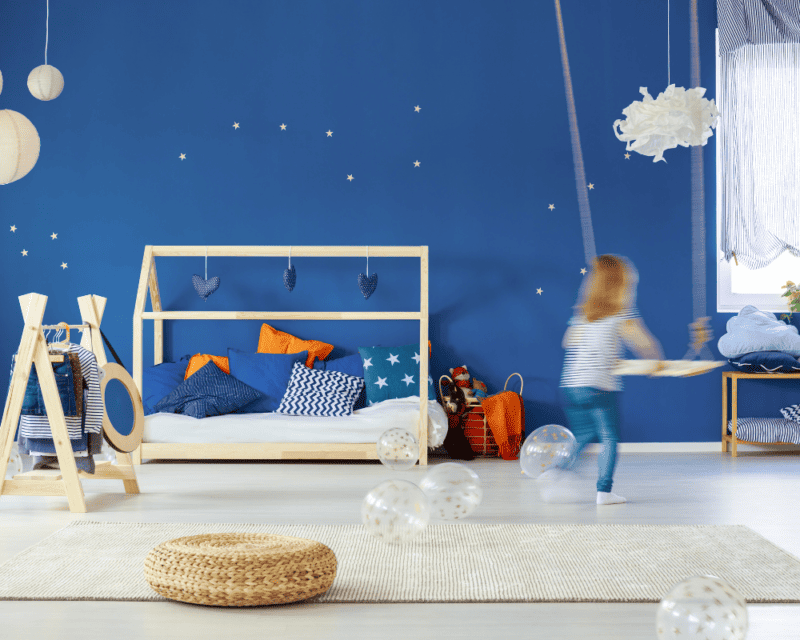Transitioning your toddler from sleeping in your room to having their own space is a significant milestone. It can be an emotional journey for both you and your child, but with thoughtful planning and the right strategies, you can make this transition as smooth as possible.
In this article, we’ll explore tips and techniques to help you successfully move your toddler into their own room, creating a comfortable and secure environment for them to sleep and grow.
Start with Safety Preparations

Before your toddler begins sleeping in their own bedroom, it’s crucial to ensure their safety. Childproof the room by securing heavy furniture to the wall, covering electrical outlets, and installing safety gates if necessary. Remove any choking hazards and create a safe sleeping environment by providing a firm crib mattress with a fitted sheet.
Additionally, consider installing a well-made smart ceiling fan to help maintain a comfortable temperature during different seasons. If you buy a smart product, you can operate it from anywhere, so you don’t have to worry about waking your child up if you feel the temperature is rising while they’re sleeping. Ceiling fans not only provide comfort by circulating air but also create a soothing background noise that can help your toddler sleep better.
Make It Familiar
One of the most effective ways to ease the transition is by making the new room feel familiar. Use some of your toddler’s favourite items, such as their stuffed animals, blankets, or nightlight, to decorate the room. By incorporating familiar elements, you create a sense of comfort and security.
Consider initially using the same crib or bedding from your room or the nursery in the new bedroom, and gradually transition to a toddler bed when your child is ready. The key is to maintain continuity while introducing them to their own space.
Create a Relaxing Bedtime Routine
Establishing a consistent bedtime routine can help your toddler feel more at ease in their new room. A routine might include activities like reading a bedtime story, singing a lullaby, or having a warm bath. The predictability of the routine signals to your child that it’s time to wind down and sleep.
Be patient and understanding during this process, as your toddler may initially resist the change. Gently reassure them with cuddles and comforting words, reinforcing that their new room is a safe and cosy place.
Gradual Transition

For some toddlers, a gradual transition works best. Begin by having them nap in their new room before moving on to overnight sleep. This allows them to become accustomed to the new environment during shorter periods. You can also try spending some time in their room with them before bedtime. Engage in quiet activities like playing with toys or reading books together.
Encourage Independence
As your toddler transitions into their own room, encourage their growing sense of independence. Offer choices like selecting their pyjamas or bedtime story. Allow them to have some control over their sleeping space by letting them decide where to place their stuffed animals or which side of the bed to sleep on. By empowering them to make small decisions, you help them feel more in control of their new environment and foster a sense of ownership.
Be Patient and Consistent
Remember that transitions can take time. Some toddlers may adapt quickly, while others require more patience and consistency. Be prepared for some nights when your child wants to return to your room or expresses anxiety about sleeping alone. Offer reassurance and comfort without being too rigid. Consistency is also key to a successful transition. Stick to the bedtime routine and establish boundaries. Over time, your child will become more accustomed to their room.
Celebrate Achievements
Celebrate your toddler’s milestones and achievements in their new space. Praise them for sleeping through the night or for being brave when sleeping alone. You could use a sticker chart or a small reward system to positively reinforce their behavior. Creating a sense of accomplishment and pride can motivate your child to continue adapting to their new sleeping arrangements.
Transition at the Right Time

Timing is essential when transitioning your toddler into their own room. Avoid making this change during significant life events or when your child is already going through a transition, such as potty training. Choose a time when your child feels secure and there are no major disruptions in their routine.
Seek Professional Guidance if Needed
If your toddler’s resistance to sleeping in their room persists and is causing distress for your child or family, consider seeking professional guidance. A paediatrician or child psychologist can provide strategies and support tailored to your child’s specific needs.
Transitioning your toddler into their new room is a significant step toward their independence and growth. Remember that each child is unique, so be patient, adaptable, and supportive throughout the process. Your toddler will thrive in their new sleeping space with time and understanding.

